Using Frugal Innovation to Serve Emerging Market Customers
This is one of our free-to-access content pieces. To gain access to all Ideas for Leaders content please Log In Here or if you are not already a Subscriber then Subscribe Here.

Using a case study of Hyundai in India in support, two professors show how multi-national corporations from developed countries can access a growing middle class in major emerging companies. The two key success factors: engaging in frugal innovation, based on frugal engineering, bricolage and modularity, and developing collaborative ecosystems.
To sell innovative products in emerging markets, companies from developed countries must take into account two fundamental facts about emerging markets. The first is that the growing middle class in emerging economies that represents the most valuable market for new products is price-sensitive — they do not earn what their middle-class counterparts in developed economies earn. At the same time, these potential customers still expect quality, robust products. Second, emerging markets are often dominated by local companies who are familiar with local conditions. These conditions are radically different from what companies from developed market are used to, and include lack of risk capital and skilled talent, political uncertainty, and often a lack of functioning institutions.
According to Rifat Sharmelly of Quinnipiac University and Pradeep Kanta Ray of the University of New South Wales, developed economy multinational corporations who want to sell innovative products will not succeed if they simply try to sell cheaper versions of their developed market products. Instead, developed economy MNCs must engage in what they call frugal innovation — developing innovative high-end technology products with low costs, in order to overcome the limited resources (including raw materials) of the market and still meet the financial constraints and quality demands of the market’s customers.
There are three distinct approaches for developing frugal innovations:
The second element for successfully developing innovative products for emerging economies is to build a collaborative ecosystem, which leads to deep embeddedness of the company in the market. A business ecosystem, as with the biology ecosystem that inspired it, involves a number of different actors who depend on each other for their success. With a collaborative ecosystem, deliberate collaboration between the actors is fundamental.
Sharmelly and Ray use an in-depth case study of Hyundai Motor India Limited (HMIL), a wholly owned subsidiary of Korea-based Hyundai and the second largest car manufacturer in India, to research the role of frugal innovation and collaborative ecosystems in helping developed market MNCs develop cost-effective and value-adding products in emerging economies. The researchers looked specifically at HMIL’s efforts to develop the Eon, an affordable car targeted to middle-class Indian buyers purchasing their first cars.
The following are examples pulled from the case study that illustrate the various elements of frugal innovation and collaborative ecosystems.
The HMIL case study offers clear lessons for developed market multi-national corporations seeking to develop innovative products for emerging markets:

Ideas for Leaders is a free-to-access site. If you enjoy our content and find it valuable, please consider subscribing to our Developing Leaders Quarterly publication, this presents academic, business and consultant perspectives on leadership issues in a beautifully produced, small volume delivered to your desk four times a year.

For the less than the price of a coffee a week you can read over 650 summaries of research that cost universities over $1 billion to produce.
Use our Ideas to:
Speak to us on how else you can leverage this content to benefit your organization. info@ideasforleaders.com